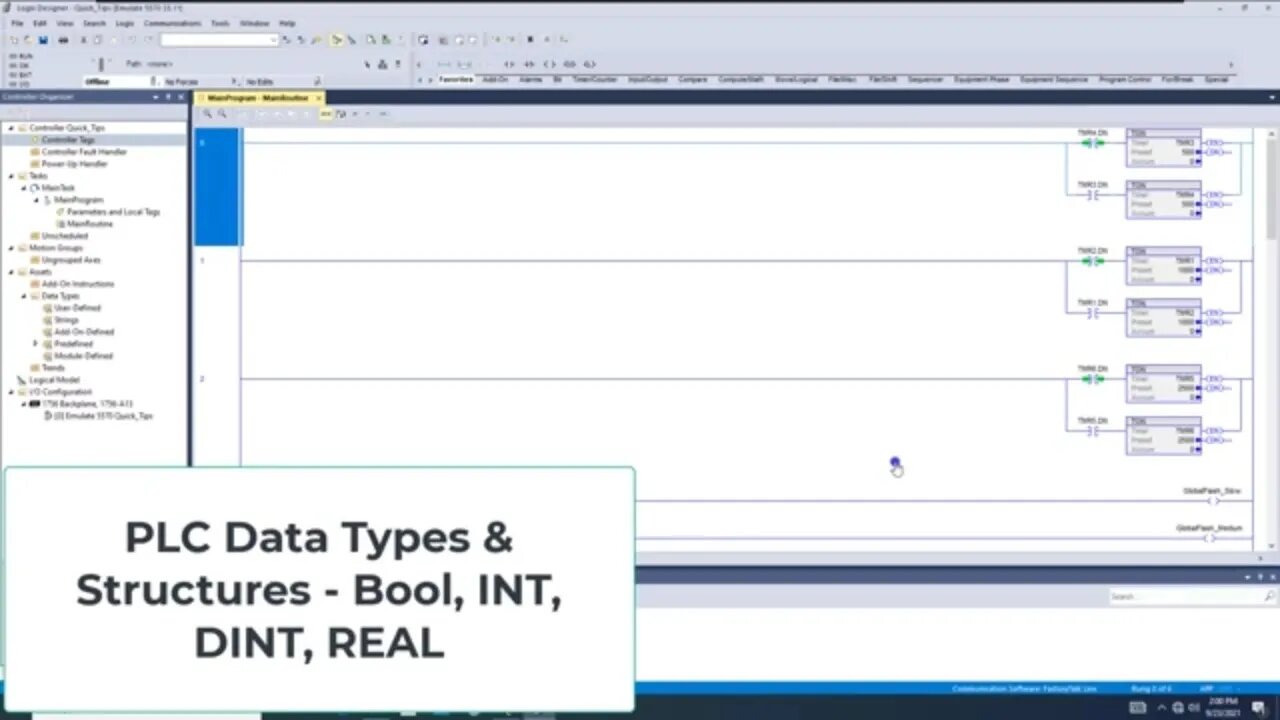Premium Only Content

PLC Data Types and Structures - Allen Bradley PLC RSLogix 5000 Basics -BOOL, INT, DINT, REAL
PLC Data Types and Structures - Allen Bradley PLC RSLogix 5000 Basics BOOL INT DINT REAL
Visit: https://onlineplcsupport.com/ for more Tutorials, Information & to connect with the Community and make you subscribe to stay up to date with our weekly videos.
The most commonly used data types you need to know when getting started with PLC programming or troubleshooting using RSLogix 5000 or Studio 5000 are BOOLs, INTs, DINTs, and REALs.
PLC (Programmable Logic Controller) data types and structures are an essential element of any PLC programming language, as they determine how data is stored, manipulated, and communicated within the system. In this article, we will focus on the PLC data types and structures used in Allen Bradley's RSLogix 5000 software, which is a popular programming platform for industrial automation applications.
One of the basic data types in RSLogix 5000 is the BOOL (Boolean) type, which can store only two values: TRUE or FALSE. This data type is often used to represent the state of a digital input or output, such as a switch or a relay.
INT (Integer) is another common data type in RSLogix 5000. It can store whole numbers within a specific range, depending on the number of bits used to represent the value. For example, a 16-bit INT can store values from -32,768 to 32,767, while a 32-bit INT can store values from -2,147,483,648 to 2,147,483,647.
DINT (Double Integer) is a data type that is similar to INT, but it can store larger values. A DINT is a 32-bit data type that can store values from -2,147,483,648 to 2,147,483,647. This data type is often used to store data that requires a higher level of precision or that may be subject to frequent changes.
REAL (Floating Point) is a data type that is used to store decimal values. It is a 32-bit data type that can store values with a precision of up to seven decimal places. REAL is often used to store data that requires a high level of precision, such as temperature or pressure readings.
In addition to these basic data types, RSLogix 5000 also supports a number of structured data types, including arrays, structures, and pointers.
Arrays are a collection of data elements that are stored in a contiguous block of memory and accessed using a single identifier. Arrays can be of any data type, including the basic data types described above, and can be one-dimensional (a single row or column of data) or multi-dimensional (multiple rows and columns).
Structures are a collection of related data elements that are stored in a contiguous block of memory and accessed using a single identifier. Structures can contain a variety of data types, including basic data types and other structures, and are often used to represent complex data structures such as machine configurations or process control systems.
Pointers are a type of data type that stores the memory address of a data element. Pointers are often used to access data stored in arrays or structures, or to pass data between functions or subroutines.
In summary, PLC data types and structures are an important aspect of any PLC programming language, and understanding how they work is essential for creating efficient and reliable automation systems. Allen Bradley's RSLogix 5000 software provides a wide range of data types and structures to meet the needs of a variety of industrial automation applications, including BOOL, INT, DINT, REAL, arrays, structures, and pointers.
In this video, we discuss the most common four to keep things within a good time length to learn & comprehend. Just 15 to 30 minutes a day is what separates the good from the great.
And I know you strive to be great at what you do so my goal is to do my part to help.
To list a more detailed list:
BOOL
SINT
INT
DINT
REAL
STRING
Arrays
0:00 Controller Tags and Program Scope Tags
1:10 PLC tag for a BOOL Data Type
1:45 PLC tag for an INT Data Type
2:25 PLC Tag for a DINT Data Type
2:40 PLC Tag for a REAL Data Type
2:55 Monitoring Tag Data
3:20 How a BOOL works
3:40 How an INT works
5:00 How a DINT works
6:15 How a REAL works
Thank you for watching the video.
Learn, Implement, Succeed
Visit:
https://www.allen-bradley-plc-training.com/
Other social media:
LinkedIn: https://www.linkedin.com/in/shane-welcher-sr/
Facebook: https://www.facebook.com/OnlinePLCSupport
#BOOL #INT #DINT #REAL
-
 3:59
3:59
Shane Welcher
1 year agoStudio 5000 Download Failed - Communications Timed Out
68 -
 2:03:39
2:03:39
Pop Culture Crisis
4 hours agoWTF Happened to Miley Cyrus? HARRY POTTER Set Images, Sydney Sweeney Hater EXPOSED | Ep. 901
30.5K18 -
 10:17
10:17
MattMorseTV
4 hours ago $5.37 earnedTrump's DOJ just DROPPED a NUKE.
23.8K33 -
 11:07
11:07
Politibrawl
12 days agoRepublican rising star DESTROYS theatrical Democrat in front of the entire world
66.7K30 -
 4:42:30
4:42:30
StoneMountain64
5 hours agoOnly game with BETTER desctruction than Battlefield?
53.6K -
 4:51:37
4:51:37
Viss
7 hours ago🔴LIVE - Viss & Dr Disrespect Take on The 5 Win Minimum PUBG Challenge!
27.5K2 -
 LIVE
LIVE
sophiesnazz
3 hours ago $0.52 earnedLETS TALK ABOUT BO7 !socials !specs
45 watching -
 1:12:05
1:12:05
The Quartering
5 hours agoToday's Breaking News!
82.3K44 -
 8:20:24
8:20:24
GritsGG
9 hours agoWin Streaking! Most Wins 3390+ 🧠
55.9K2 -
 2:20:00
2:20:00
Tucker Carlson
6 hours agoDave Collum: Financial Crisis, Diddy, Energy Weapons, QAnon, and the Deep State’s Digital Evolution
128K116